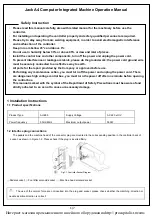
OPERATING PROCEDURES
WARNING! For the safe operation of this machine
follow the instructions given in this booklet and the
training given by your supervisor. Failure to do so can
result in personal injury and/or damage to machine and
property!
DO NOT OPERATE MACHINE IN AN EXPLOSIVE
ENVIRONMENT!
NEVER USE THIS MACHINE TO PICK UP VOLATILE
OR EXPLOSIVE MATERIALS!
The model shown in this manual is intended for commercial
use.
PREPARATION
1. Check
power cord
,
plug
and
strain relief
for worn or
damaged insulation. Repair or replace if necessary.
2. Confirm the
quick connects
located at the back of the
machine are properly attached. This is the water sup-
ply line and solution water will not be allowed to flow
through to the jets if this connection isn’t secure.
3. Lock the
brush assembly
in the up position for storage
or transport. This is done by pulling up on the
black
knob/lift mechanism
at the front of the machine and
allowing the lift stop to rest on the bracket.
4. Inspect the
vacuum head
and
brush
by tilting the
machine backwards.
a)
Vacuum Head:
Check for any damage. Burrs on
the contact surface may snag carpet fibers. Gouges,
scratches and chipped areas can reduce vacuum
performance.
b)
Brush:
Inspect for damaged or missing bristles,
replace if necessary.
Return the machine to the upright position.
OPERATION
The following procedures are intended to describe and detail
proper operation of your machine. Failure to follow these
recommended procedures can reduce the machine’s perfor-
mance and may result in damage to the machine.
1.
Vacuum
the area to be cleaned
. Your machine will
do a more thorough job if the loose dirt and debris are
removed before the extraction process begins.
2.
Add NON-FOAMING cleaning concentrate to the
fresh water/solution tank.
Follow mixing instructions
for 3 to 3-1/2 gallons of water.
Then fill the tank with
warm water using the faucet/power fill adaptor
. Do
not use water hotter than 60
°
C (140
°
F).
Or, you may mix the concentrate with 3 to 3-1/2 gal-
lons of clean water in a CLEAN bucket, then pour the
mixture into the solution tank.
DO NOT OVERFILL.
NEVER USE THE RECOVERY TANK’S DIRTY
WATER TO FILL THE SOLUTION TANK!
3.
Ensure the water supply hose connection at the rear
of the machine is secure.
4.
Connect the power cord plug to a
115 volt
grounded
wall socket
. See Grounding Instructions. Use of an
extension cord is not recommended. However, if one is
necessary, use only a
14 gauge
or larger cord. Smaller
or inferior cords are dangerous and may cause damage
to your machine.
5.
Lower the brush assembly
by lifting theblack knob
off the storage/transport bracket.
6.
Turn on the
vacuum switch at the control panel
to
start the vacuum motor.
Note: The accessory pump switch is for use only with
the accessory tools. See “OPERATING WITH ACCES-
SORY TOOLS”.
7.
Pull
backward during operation
. DO NOT AT-
TEMPT TO OPERATE IN A FORWARD DIRECTION.
Position yourself behind the machine, grasp the
handle and depress the red momentary “Pump/
Brush” switch on the top center of the handle
. This
switch activates the brush drive motor and the pump
to spray cleaning solution. Walk slowly backward and
continue to depress the red switch to perform the clean-
ing process.
5. Check the
inlet screen and filter bag
in the opening
of the fresh water/solution tank for damage or debris.
Holes in the screen can allow contaminants to enter the
pump resulting in costly repairs. A clogged screen will
reduce pump performance and may cause permanent
damage.
6. Remove the clear dome on top of the recovery tank.
a) Inspect for damage to the
dome
and
gasket
. Dirt
or debris on the gasket or sealing surface of the tank
can cause a vacuum leak and reduce vacuum
performance.
b) The
intake filter screen
should be clean of debris
and checked periodically for any damage, replace
if necessary.
Return the cover to its original position.
4
Summary of Contents for ACHIEVER 40
Page 7: ...7 Achiever 40 Wiring Diagram...
Page 8: ...Achiever 40 Drawing 1 8 03 01...
Page 10: ...Achiever 40 Drawing 2 03 01...






























